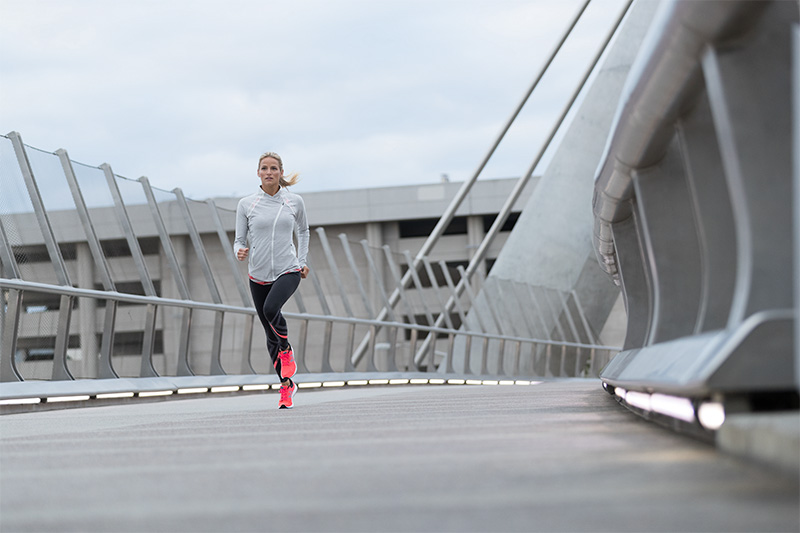Winter Weather Workouts
Published on December 6, 2022
Winter brings snow and rain which has an impact on our workouts. We need to keep training for races over the next two months. Often you can be running on snow or in heavy rain to keep up with your training plan.
There are several options to help you keep fit: you can substitute your workouts with cross training; run on a treadmill; run outside at an easier pace and consider your running gear.
You can complete your easy runs on snow but it is a little more difficult to do tempo runs or speed-work unless the streets are clear or salted. Trail shoes add extra grip in icy and snowy conditions. If they are gore-tex shoes they will keep your feet much warmer on cold days and drier in wet weather. A rainy day? Run with carbon plated shoes to counter the water weight and maintain pace.
Are you a fair weather runner but you want to run a race? Here are a few ideas to help you make it to the start line in great shape.
CROSS TRAINING
In the winter you can limit your running to three runs plus cross training. In moderate winter conditions you should be able to complete all three weekly runs outdoors. We suggest you add extra aerobic volume with non weight bearing cross training. In severe conditions you can substitute running workouts with indoor cross training for 45 minutes to one hour.
How can you cross train to prepare for a big race?
Try running in the pool; which boosts aerobic endurance and is very specific to the running motion. Stationary biking allows you to do an intense work-out and can be used as a substitute for speed-work by breaking down your time into sets of intervals. Rowing can improve your aerobic fitness while strengthening arms, back and quadriceps.
Start out with a shorter 20 minute cross training session to adapt to the new activity and then increase the time by 5 or 10 minutes each session. Usually I can train indoors for about 45 minutes at most but you may want to work-out for up to an hour. I also like to mix cross training sessions; stationary biking 15 minutes, rowing 15 minutes and stationary biking 15 minutes to break up the workout.
High intensity cross-training
If you are skipping a run because of bad weather you can continue to follow your training schedule by substituting the tempo runs and speedwork with high intensity cross training. You could substitute tempo runs by increasing the intensity of your stationary bike or elliptical session for the same amount of time. A 5km tempo run could turn into a 25 minute high intensity elliptical session. For speedwork on a stationary bike, you can pedal for the same time as the repeats and rest; ex. 5 x 3 minutes fast with a 3 minute rest.
Increase aerobic fitness while training indoors
Another reason to cross train is you may be able to improve your fitness without the risk of injury due to high weekly mileage. Our training program includes three primary runs per week:
- Easy long run slower than race pace
- Speed workout at 10km pace
- Tempo workouts at a fast pace, half marathon pace, and marathon pace
In addition to these three primary runs you may want to increase your aerobic fitness by cross training two more times per week. The best cross training for runners are non weight bearing exercises such as swimming , cycling, rowing or pool running. They offer the least chance of injury than weight bearing cross training such as stair machine or elliptical.
Run substitution to avoid injury
During our training build up towards a race we increase the distance of the long run week after week. As we build up the distance of our Saturday runs you may begin to experience some aches and pains. It could be regular training pains or the start of something more serious. If your hamstring is aching, knee is beginning to become sore, you may want to try cross training to let the potential injury settle down. If you think you are developing an injury, don’t run for six days, let it get better before it gets worse. Cross train instead. You won’t lose any fitness cross training and may even be better off by strengthening other muscles. Remember the number one goal of our run clinic is to get you to the start line.
Improve race time
Is cross training really going to help your race time? How does cycling translate to running faster? Many top athletes have improved their fitness through cross training and have had stellar results. Many triathletes are fast runners and usually run two or three times per week.
Running three times per week is all the running you need for a marathon or half marathon. It helps to keep a positive approach about your running, which includes cross training. It does not matter how you get to the start and finish lines as long as you do.
TREADMILL TRAINING
If you have access to a treadmill you can always workout indoors. Running indoors is warmer and you need to dress as if you are running in the heat of the summer. Stay hydrated. You may want to set your treadmill at a slight incline to equate to running outdoors because the treadmill does some of the work. An incline will make the difficulty level the same as outdoors.
Rain or snow – Outdoor jog plus treadmill fast
To add variety, you can mix your treadmill runs with outdoor running. Run the first 2/3 of the distance outside and the final 1/3 on the treadmill at a faster pace.
Intervals on treadmill
Forerunners speed workouts are set-up as intervals by minutes rather than distance which translates easily to treadmill running. For example this speed workout could easily be programmed into a treadmill: warm-up 10 minutes+ 6×3 minutes (10km pace)[1 minute rest]+warm-down.
JUST RUN EASY
Enjoy the cooler weather by running easy in the snow or rain. A week of easy pace running will not significantly impact your race fitness and will allow you to recover and rest-up for faster training in the weeks ahead.
RUN WITH LIGHTER SHOES IN RAIN
Carbon plated shoes are new to running and are thought of primarily for racing. The carbon plates shoes are extremely light and the plate in the shoe helps to propel you along at a faster pace. The carbon plates offer unusually good cushioning not found in regular racing shoes. It’s an exhilarating feeling to be running along in a workout ten to twenty seconds per km faster than usual. If you run in these light weight speedy shoes on a rainy day they help to offset the extra weight from wet running gear. And, mentally it’s motivating to think that you can put on a pair of fast shoes to help you through a rainy winter workout.
RUN WITH TRAIL SHOES IN SNOW
Another solution to snowy conditions is to run in trail shoes. Streets and sidewalks can remain covered in snow for days. Trail shoes will improve traction and allow you to continue training outdoors. For added warmth run with Gore Tex trail shoes.
For running on snow there’s the New Balance Fresh Foam X Hierro. The Fresh Foam X Hierro v7 GTX employs a Vibram® Megagrip outsole and a GORE-TEX® waterproof lining to create a protective shell of durability and traction around the signature Fresh Foam X cushioning.
- 8 mm drop; due to variances created during the development and manufacturing processes, all references to 8 mm drop are approximate
- Fresh Foam X midsole delivers our most cushioned Fresh Foam experience for incredible comfort
- Synthetic and mesh material
- GORE-TEX® waterproof fabric protects feet from wind, rain and water without sacrificing breathability
- Upper features a breathable yet protected construction
- Upper features no-sew overlays for a sleek fit and feel
- Vibram® Megagrip outsole provides superior grip.
STAY MOTIVATED DURING THE WINTER
The key to winter running is to have a plan. You can join a run group that is committed to a specific race program and has a set workout schedule. Once you have joined and are part of a group it’s easier to workout if you have specific times to meet for training. Have a contingency plan to train indoors in the event of bad weather or a potential injury. If you have a goal and a group to run with and a training plan that will provide the tools you need to make it to the startline on race day.




